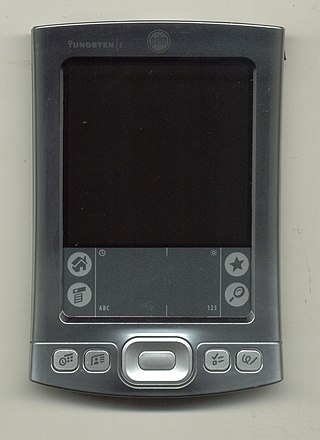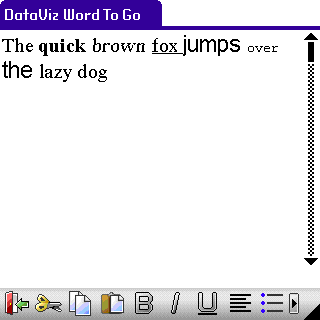
The Sony CLIÉ is a series of personal digital assistants (PDAs) running the operating system (OS) Palm OS, developed and marketed by Sony from 2000 to 2005. The devices introduced many new features to the PDA market, such as a jog dial interface, high-resolution displays, and Sony technologies like Memory Stick slots and ATRAC3 audio playback. Most models were designed and manufactured in Japan. The name was initially an attempt at a new coinage term, though it means tool in the Jèrriais language.

Palm OS was a mobile operating system initially developed by Palm, Inc., for personal digital assistants (PDAs) in 1996. Palm OS was designed for ease of use with a touchscreen-based graphical user interface. It is provided with a suite of basic applications for personal information management. Later versions of the OS have been extended to support smartphones. The software appeared on the company's line of Palm devices while several other licensees have manufactured devices powered by Palm OS.

Palm, Inc. was an American company that specialized in manufacturing personal digital assistants (PDAs) and developing software. They were the designer of the PalmPilot, the first PDA successfully marketed worldwide, and were known for the Treo 600, one of the earlier successful smartphones. Palm developed the Palm OS software for PDAs and smartphones, which were released under its line of Palm-branded devices and also licensed to other PDA manufacturers.

Palm is a line of personal digital assistants (PDAs) and mobile phones developed by California-based Palm, Inc., originally called Palm Computing, Inc. Palm devices are often remembered as "the first wildly popular handheld computers," responsible for ushering in the smartphone era.
The Zire Series was Palm, Inc's "consumer-grade" brand of Personal Digital Assistant.

The Tapwave Zodiac is a mobile entertainment console. Tapwave announced the system in May 2003 and began shipping in October of that same year. The Zodiac was designed to be a high-performance mobile entertainment system centered on video games, music, photos, and video for 18- to 34-year-old gamers and technology enthusiasts. By running an enhanced version of the Palm Operating System (5.2T), Zodiac also provided access to Palm's personal information management software and many other applications from the Palm developer community. The company was based in Mountain View, California.

The Tungsten series was Palm, Inc.'s line of business-class Palm OS-based PDAs.
Descended from Copilot, Palm OS Emulator is used for writing, testing, and debugging Palm OS applications. Palm OS Emulator emulates Motorola 68000-class devices and has intimate knowledge of Palm OS's inner working, allowing for the close monitoring of correct application operation. Unlike Xcopilot, Palm OS Emulator will not boot uClinux. By using "skin" files, Palm OS Emulator could very closely mimic the appearance of many models of Palm handheld.

The Zire 31 is a Zire Handheld from palmOne. The product was first released in April 2004 as a replacement for Zire 21. It runs Palm OS 5.2.8 and features a color 160×160 display, a SDIO slot and a standard 3.5mm stereo headphones jack. The improved PIM apps are supplied. The ROM includes RealOne Player giving the device some digital audio player capabilities. They can be extended with 3rd party software, such as TCPMP. The Zire 31 has a 5-way navigator pad, but still only 2 quickbuttons, as opposed to the standard 4 on the mid-range Zires 71/72. It was replaced by the Z22, which lacks the SD/MMC/SDIO Expansion and headphone jack.

Documents To Go is BlackBerry's cross-platform office suite for Palm OS, Windows Mobile, Maemo, BlackBerry OS, Symbian, Android, and iOS. Also, a larger-screen version would have been included with the Palm Foleo, but Palm, Inc. cancelled the device before its release.

The Z22 was one of the first of Palm, Inc.'s handhelds to be released under the new "Palm" brand, and the first to be released without the "Zire" moniker. Released on October 12, 2005, it replaced the monochrome Zire 21, and was priced at $99 USD. The Palm Z22 came with Palm OS Garnet 5.4.9 preloaded and is not upgradable. It featured a 200 MHz Samsung S3C2410 ARM processor developed around the 32-bit ARM920T core that implements the ARMv4T architecture. The Z22 ran on a li-ion battery that had a life of about 8 hours depending on usage.

The Palm III is a personal digital assistant that was made by the Palm Computing division of 3Com. It went on sale in 1998 as a replacement for the PalmPilot handheld. It was the first Palm handheld to support infrared file transfer and a Flash ROM-capable operating system. At release, the Palm III was priced at US$400.

The Palm IIIxe is a discontinued Palm personal digital assistant that was designed and manufactured by Palm, Inc. It cost US$249 when new.

Blazer was a web browser available for Palm handhelds running Palm OS 3.1 or higher.

The Jornada was a line of personal digital assistants or PDAs manufactured by Hewlett-Packard. The Jornada was a broad product line that included Palm-Size PCs, Handheld PCs, and Pocket PCs. The first model was the 820, released in 1998, and the last was the 928 model in 2002 when Compaq and HP merged. The Jornada line was then succeeded by the more popular iPAQ model PDAs. All Jornada models ran Microsoft Operating Systems that were based on Windows CE.
The Palm m500 series of handheld personal digital assistants consisted of three devices: the Palm m500, Palm m505, and Palm m515. The series was a follow-up to the popular Palm V series with a similar, though slightly shorter, footprint and form factor.

HandEra was a manufacturer, software developer, and service contractor. HandEra's business previously revolved around Palm OS, and devices running Palm OS. The company's headquarters were in Des Moines, Iowa.
The Clie PEG-VZ90 is a Personal Digital Assistant (PDA) made by Sony. It ran the Palm OS and was the last of the CLIÉ line. The PEG-VZ90 was released in 2004, only in Japan, and was made in the form of a Mini Tablet PC. It was the first handheld to have an OLED display.
Handspring, Inc. was an American electronics company founded in 1998 by the founders of Palm, Inc. after becoming dissatisfied with the company's direction under new owner 3Com. The company developed Palm OS–based Visor- and Treo-branded personal digital assistants. In 2003, the company merged with Palm, Inc.'s hardware division.














